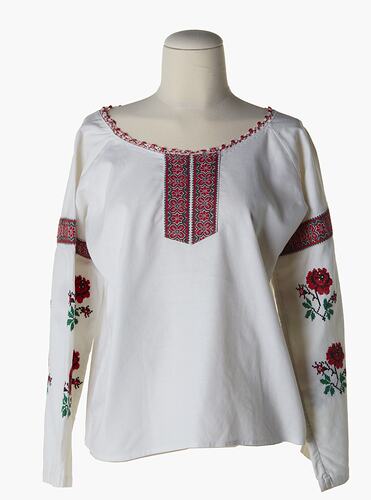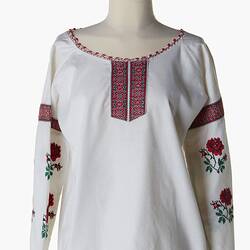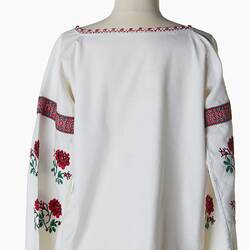Summary
Blouse hand-made and embroidered by Natalie Senjov-Makohon to dance at concerts whilst she was part of a Ukrainian Dancing Group, Melbourne, late 1960s-early 1970s. She did not embroider all the strips. Natalie purchased some detailing from Jobs Warehouse in Bourke Street Melbourne as she did not have time to complete it (her mother Katerina was horrified!)
This item is part of a collection of textiles, cultural objects and photographs relating to the migration and settlement experiences of Katerina Senjov, and her daughter Natalie Senjov-Makohon who inherited her mother's passion for maintaining her Ukrainian cultural heritage.
Katerina Senjov (nee Burlak) and her husband Peter migrated to Melbourne from what is now Bosnia-Herzegovnia in 1954. Despite growing up in Bosnia, the Senjov and Burlak families always culturally identified as Ukrainian and spoke Ukrainian language.
They settled first in Geelong and then in Ascot Vale, had two children Natalie and Steven, whom they encoraged to learn traditional Ukrainian culture and traditions. The Senjovs actively participated in the Ukrainian community (including choirs, dance groups and gatherings wearing traditional regional clothing usually made by Katerina or her daughter Natalie).
The mother and daughter produced, wore, used, purchased and received, a range of Ukrainian cultural items including embroidered domestic and religious textiles, Ukrainian textile design publications, Pysanky (hand-painted eggs), a Bandura (stringed musical instrument) and timber inlay artworks.
Physical Description
Thick white cotton blouse with red, green and black cross-stitch flowers on wide sleeves, red and grey applied trim down front and at shoulders and red stitch trim around neckline.
Significance
This collection provides a significant representation of traditional Ukrainian life and cultural practices subsequently transported to Australia through migration, and retained as part of the preservation, maintenance and adaptation of cultural life. In this family there was a strong and active passing down of cultural traditions. particularly down the female line.
The Museum holds a range of regional costumes, or costume components, from Sardinia, Latvia, Estonia, Poland, South Africa, Albania, Scotland, Greece, Hungary, Slovenia and Argentina; this collection relating to Ukraine further strengthens and expands the cultural representation of the collection. This material has been worn and used, is well provenanced, and has accompanying photographic documentation. This collection is also an important addition to the currently small collection relating to Ukrainian migration and settlement experiences.
The collection also includes domestic and religious Ukrainian embroidery and weaving, books documenting traditional Ukrainian designs used as references by the makers in Australia, Pysanky (painted eggs) in the tradition of many eastern European countries including Ukraine, and a Bandura (Ukrainian traditional musical instrument).
These items were all of importance in the expression of identity and place, some in the country of origin, and all in the place of re-settlement. Some of the costume pieces have played a role in the activities of community organisations in Australia; like similar associations, maintaining cultural practices and customs is increasingly challenging as subsequent generations become further distanced from the original migrant generation and through the natural process of community settlement, integration and assimilation within the context of a multiculturally diverse society.
More Information
-
Collection Names
-
Collecting Areas
Migration & Cultural Diversity, Clothing & Textiles, Home & Community, Leisure
-
Maker
-
Classification
-
Category
-
Discipline
-
Type of item
-
Object Dimensions
590 mm (Length), 540 mm (Width)
590mm top of shoulder to hem; 620mm sleeve length; 540mm waist width
-
Keywords
Ukrainian Immigration, Women's Clothing, Needlework, Handcrafts, Cultural Traditions, Embroidery, Weaving, Sewing, Cultural Identity, Artworks, Crafts, Clothing


